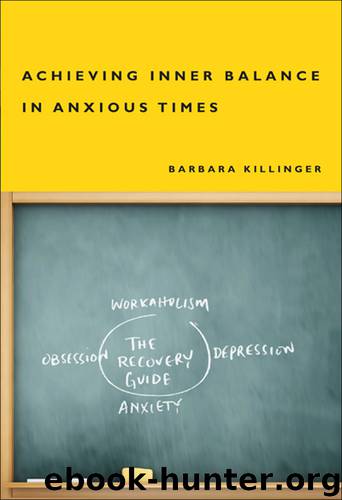Achieving Inner Balance in Anxious Times by Barbara Killinger

Author:Barbara Killinger [Killinger, Barbara]
Language: eng
Format: epub
Publisher: MQUP
Published: 2011-08-01T16:00:00+00:00
You can handle moderate levels of sadness with little obvious discomfort. However, both ends of the stress curve cause equal discomfort. The lower end – not being able to express sadness – is stressful. As an example, have you ever attended a funeral and worried that you might sob uncontrollably if you let yourself go? To prevent this, you force yourself to tune out of the service, to think about something else. You do manage to get through it, but this blocking off effort has taken its toll on your energy.
Near the upper range of the curve, your sadness level is elevated to the point that you are obviously experiencing discomfort and even pain. Tears are spilling down your face, and there is a choking sensation in your throat.
2–5. SOUNDING THE ALARM The crucial question to ask at this point in the internalizing process is, am I still comfortable and in control or am I becoming overstressed?
I know when I’m not okay because I get a “jiggly” or agitated feeling, and I can’t sit still. I call this sensation “feeling yucky.” Naming the reaction helps me take responsibility for it and sends a signal that I better start problem-solving right away. Otherwise, my defenses will mobilize and complicate or block my ability to seek solutions. Words such as irritated, perturbed, antsy, or “hyper” may better describe your distress signals.
Before you are ready to problem-solve, however, there is one more step. Take time to fully feel your emotions.
Download
This site does not store any files on its server. We only index and link to content provided by other sites. Please contact the content providers to delete copyright contents if any and email us, we'll remove relevant links or contents immediately.
Rewire Your Anxious Brain by Catherine M. Pittman(18231)
Talking to Strangers by Malcolm Gladwell(12828)
The Art of Thinking Clearly by Rolf Dobelli(9853)
Mindhunter: Inside the FBI's Elite Serial Crime Unit by John E. Douglas & Mark Olshaker(8669)
Becoming Supernatural by Dr. Joe Dispenza(7810)
Change Your Questions, Change Your Life by Marilee Adams(7344)
The Road Less Traveled by M. Scott Peck(7258)
Nudge - Improving Decisions about Health, Wealth, and Happiness by Thaler Sunstein(7216)
The Lost Art of Listening by Michael P. Nichols(7140)
Mastermind: How to Think Like Sherlock Holmes by Maria Konnikova(6912)
Enlightenment Now: The Case for Reason, Science, Humanism, and Progress by Steven Pinker(6857)
Win Bigly by Scott Adams(6804)
The Way of Zen by Alan W. Watts(6271)
Daring Greatly by Brene Brown(6210)
Big Magic: Creative Living Beyond Fear by Elizabeth Gilbert(5325)
Grit by Angela Duckworth(5278)
Men In Love by Nancy Friday(4948)
Ego Is the Enemy by Ryan Holiday(4922)
Altered Sensations by David Pantalony(4847)
